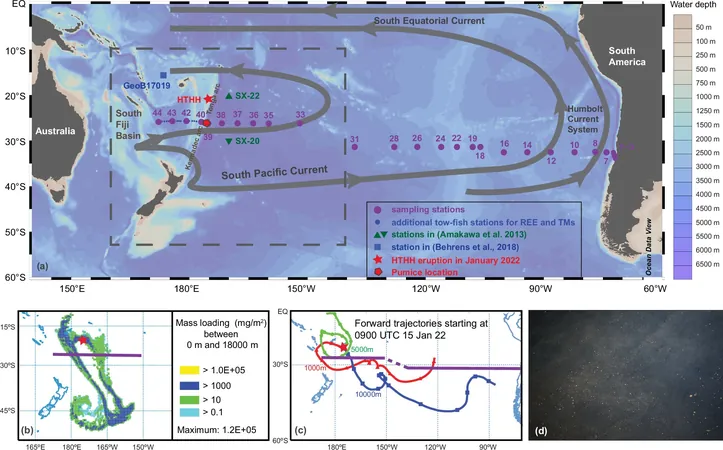
Hunga Tonga Eruption: A Volcanic Gift That May Transform South Pacific Ecosystems!
2024-11-06
Author: Wei
In January 2022, the Hunga Tonga-Hunga Ha'apai (HTHH) eruption unleashed an astonishing 2.9 billion tons of volcanic material into the atmosphere, scattering it across the South Pacific. This monumental event prompted a scientific expedition (GEOTRACES GP21) aimed at investigating its dramatic impact on the biogeochemistry of the South Pacific Gyre (SPG) surface waters.
The research team’s primary focus was on analyzing the concentrations of trace elements in the ocean and understanding how these changes might influence marine life. Their findings have been shared in the prestigious journal Nature Communications, revealing insights that could shape our understanding of volcanic eruptions as crucial contributors to marine ecosystems.
Volcanic Ash: A Blessing in Disguise for Marine Life
To thoroughly analyze the eruption's effects, researchers employed cutting-edge computer simulations alongside comprehensive water sample analyses. They utilized the HYSPLIT model from the National Oceanic and Atmospheric Administration (NOAA) to simulate the dispersion of volcanic ash in the atmosphere, tracking its movement over 72 hours and analyzing trajectories for up to 315 hours.
During their expedition, which took place from February to April 2022 aboard the SONNE vessel as part of the international GEOTRACES program, the scientists collected vital water samples along a predetermined route. They observed and gathered vast amounts of floating tephra, predominantly pumice, in the western SPG.
Notably, by analyzing radiogenic neodymium isotopes and rare earth element concentrations, the team was able to determine significant volcanic input into the western region of the SPG— identified as the focal point for post-eruption deposition according to their ash dispersion model. Furthermore, seawater analyses revealed a correlation between increased volcanic input and higher levels of chlorophyll-a, a key indicator of phytoplankton growth.
Nutrients From the Deep: The Phytoplankton Boom
Research teams discovered that the western SPG had witnessed an influx of key trace elements such as iron and neodymium, normally introduced into the ocean only in trace amounts via atmospheric dust. The Hunga Tonga eruption contributed 32,000 tons of iron and 160 tons of neodymium, a significant boost compared to typical annual inputs for the region.
Dr. Zhouling Zhang, a research associate in the Paleo-Oceanography Research Unit and the study's lead author, shared, “We observed increased chlorophyll-a concentration in surface waters, pinpointing a surge in phytoplankton growth and biological activity.”
A Potential Climate Change Ally?
The team posited that the trace elements released by volcanic eruptions, particularly iron, are pivotal in stimulating marine biodiversity. This nutrient influx promotes phytoplankton growth, which plays a critical role in the global carbon cycle by capturing CO₂ through photosynthesis and sequestering it in the ocean.
This increase in biological productivity could enhance the ocean’s capacity to absorb atmospheric CO₂, with substantial long-term climate implications. Notably, the researchers compared the iron influx from the Hunga Tonga eruption to the phenomenon seen after the eruption of Mount Pinatubo in June 1991, which had resulted in a notable 1.5 ppm decrease in atmospheric CO₂ rise about two years post-eruption due to similar ocean fertilization effects.
Zhang indicated their hopeful stance, asserting, “We believe the Hunga Tonga eruption could yield comparable effects and serve as a reminder of the complex interplay between natural events and climate regulation.”
As scientists continue to navigate the repercussions of such volcanic eruptions, the lessons drawn from the Hunga Tonga event may shape future ecological and climate research, potentially turning disaster into opportunity for revitalizing ocean health. Stay tuned—this could revolutionize our strategies for tackling climate change!




 Brasil (PT)
Brasil (PT)
 Canada (EN)
Canada (EN)
 Chile (ES)
Chile (ES)
 España (ES)
España (ES)
 France (FR)
France (FR)
 Hong Kong (EN)
Hong Kong (EN)
 Italia (IT)
Italia (IT)
 日本 (JA)
日本 (JA)
 Magyarország (HU)
Magyarország (HU)
 Norge (NO)
Norge (NO)
 Polska (PL)
Polska (PL)
 Schweiz (DE)
Schweiz (DE)
 Singapore (EN)
Singapore (EN)
 Sverige (SV)
Sverige (SV)
 Suomi (FI)
Suomi (FI)
 Türkiye (TR)
Türkiye (TR)